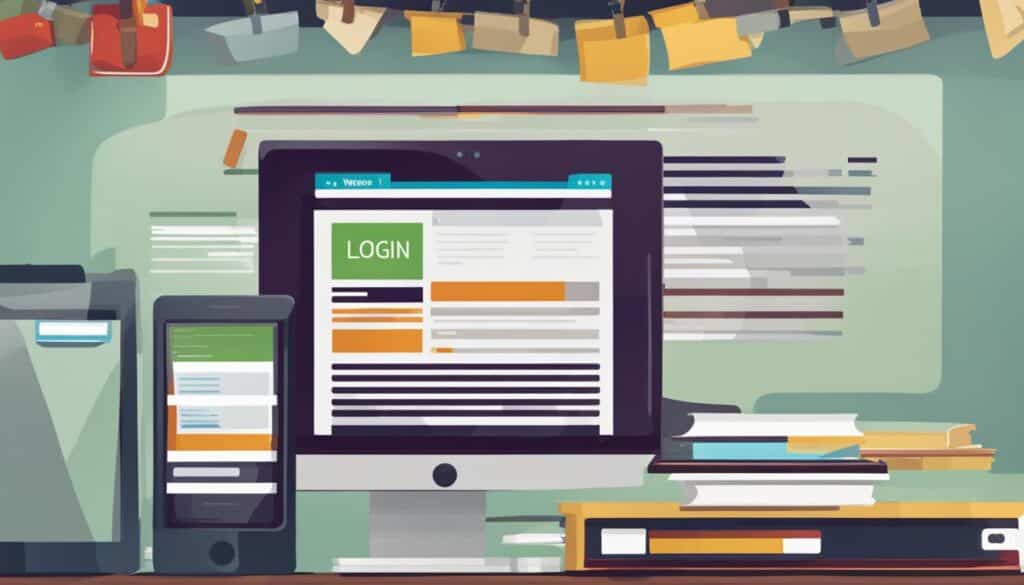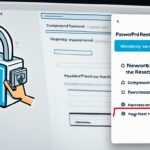Table of Contents
Welcome to our comprehensive WordPress login guide! If you’ve ever wondered how to access your WordPress admin area or login to WordPress, you’re in the right place. In this guide, we will walk you through the various methods to find your WordPress login URL and provide tips for customizing and securing your login page.
Logging in to your WordPress website is the first step to managing your site’s content and settings. Whether you’re a beginner or an experienced user, understanding how to access the admin area is essential for a smooth WordPress experience.
Are you ready to start exploring WordPress login methods? Let’s dive in!
Before we proceed, it’s important to note that the process of logging in to WordPress may vary slightly depending on your website’s setup and hosting provider. However, we will cover the most common methods that apply to the majority of WordPress installations.
How to Find Your WordPress Login URL
When it comes to accessing your WordPress login page, it’s important to know the correct URL. Fortunately, finding your WordPress login URL is a straightforward process.
The simplest way to find your WordPress login URL is to add “/admin” or “/login” to the end of your site’s URL. For example, if your site is “www.example.com,” your login URL would be “www.example.com/admin/” or “www.example.com/login/”.
If your login URL is not working properly, there’s an alternative method to access it. You can try accessing it directly by adding “/wp-login.php” to the end of your site’s URL. So, using the previous example, your login URL would be “www.example.com/wp-login.php”.
In some cases, you might have installed WordPress in a subdirectory or subdomain. If that’s the case, you need to adjust the login URL accordingly. For example, if WordPress is installed in a subdirectory called “blog,” your login URL would be “www.example.com/blog/wp-admin/”. Similarly, if it’s installed on a subdomain called “news,” your login URL would be “news.example.com/wp-admin/”.
Remember, it’s crucial to keep your WordPress login URL secure and avoid sharing it with unauthorized individuals. Protecting your login page is the first line of defense against potential breaches.
Now that you know how to find your WordPress login URL, you can easily access the admin area and manage your website’s content and settings.
| Method | Login URL |
|---|---|
| Default URL | www.example.com/admin/ or www.example.com/login/ |
| Alternative URL | www.example.com/wp-login.php |
| Subdirectory Installation | www.example.com/blog/wp-admin/ |
| Subdomain Installation | news.example.com/wp-admin/ |
Using ‘Remember Me’ to Bypass Login Page in WordPress
The ‘Remember Me’ feature in WordPress provides a convenient way to bypass the login page on subsequent visits. When you check the ‘Remember Me’ checkbox on the login page, you will stay logged in for 14 days or according to your browser’s cookie settings. This means that you can skip the login process and access your WordPress admin area directly.
By utilizing the ‘Remember Me’ feature, you can save time and streamline your workflow. Instead of entering your username and password every time you visit your website, the ‘Remember Me’ option keeps you logged in for extended periods.
However, it’s important to note that enabling ‘Remember Me’ on public or shared devices may pose security risks. Use this feature responsibly and avoid selecting it on computers or devices that others can access.
“The ‘Remember Me’ feature in WordPress allows you to bypass the login page and directly access your admin area, saving you time and effort.”
If you prefer to always stay logged in to your WordPress site, you have the option to use code or plugins to automatically enable the ‘Remember Me’ feature during the login process. These methods can override the default behavior, ensuring that you are always signed in to your WordPress website.
Remember Me feature in WordPress provides a seamless login experience, allowing you to swiftly access your admin area without the hassle of repeatedly entering your credentials. This feature proves especially useful for frequent website administrators who require quick access to their WordPress dashboard.
Example Code to Enable ‘Remember Me’ by Default:
You can add the following code snippet to your WordPress theme’s functions.php file to enable the ‘Remember Me’ checkbox by default:
function auto_remember_me() {
add_filter( 'login_footer', 'rememberme_checked' );
}
function rememberme_checked() {
echo '<script>jQuery(function($) { $(\'#rememberme\').prop(\'checked\', true); });</script>';
}
add_action( 'login_enqueue_scripts', 'auto_remember_me' );
This code automatically checks the ‘Remember Me’ checkbox on the login page, ensuring that you stay logged in to your WordPress site. Remember to backup your theme files before making any modifications and use caution when editing code directly.
Plugins to Enable Auto ‘Remember Me’:
If you prefer a plugin-based solution, there are several WordPress plugins available that can automatically enable the ‘Remember Me’ feature during the login process. These plugins offer various customization options and provide additional features to enhance your login experience.
| Plugin Name | Description |
|---|---|
| Remember Me Checked | This lightweight plugin automatically checks the ‘Remember Me’ checkbox on the WordPress login page, ensuring that you remain logged in even after closing the browser. |
| Auto Remember Me | This plugin automatically enables the ‘Remember Me’ option when logging in to WordPress, saving you time and clicks every time you visit your admin area. |
| WP Remember Me Checkbox | With this plugin, you can configure the ‘Remember Me’ checkbox to be checked by default or set the duration of the ‘Remember Me’ cookie. |
Using these plugins, you can effortlessly enable the ‘Remember Me’ feature in your WordPress login process without modifying any code.
Remember to use caution when utilizing the ‘Remember Me’ feature and make informed decisions based on your specific circumstances. This feature can greatly enhance the login experience in WordPress, but it also carries potential security implications.
Adding a Login Link to Your WordPress Website
To provide convenient access to your WordPress login page, you can add a login link to prominent areas of your website such as the menu, footer, or sidebar. This allows you and your users to quickly navigate to the login page without searching for the URL.
- Adding a Login Link through the WordPress Admin Area:
To add a login link through the WordPress admin area, follow these steps:
- Log in to your WordPress website.
- Go to Appearance > Menus.
- Select the menu where you want to add the login link.
- Click on the “Custom Links” tab.
- Enter your WordPress login URL in the URL field. For example, www.yourwebsite.com/wp-login.php.
- Provide a custom link text like “Login” or “Admin Login” in the link text field.
- Click the “Add to Menu” button.
- Save your menu.
Your login link will now be displayed in the chosen menu on your website, allowing visitors to access the login page with ease.
- Using the Meta Widget:
If you’re looking for a quick and simple way to add a login link to your sidebar or footer, you can use the Meta widget. Here’s how:
- Go to Appearance > Widgets in the WordPress admin area.
- Locate the “Meta” widget.
- Drag and drop the Meta widget to your desired sidebar or footer area.
- Save the changes.
The Meta widget will automatically display a login link, allowing users to access the WordPress login page directly.

Creating a Custom Login Page with Plugins
If you want to go beyond a simple login link and create a custom login experience for your users, you can utilize plugins like SeedProd or WPForms. These plugins offer advanced customization options to design a branded login page that aligns with your website’s aesthetics and goals.
With SeedProd, you can use its drag-and-drop builder to create a visually appealing and user-friendly login page. It also provides features like background images, custom colors, and login form customization.
Alternatively, WPForms allows you to create custom login forms with ease. You can add your logo, custom fields, and even redirect users to different pages after login.
By leveraging these plugins, you can enhance the login experience for both you and your users, strengthening your website’s overall appeal and brand presence.
Logging in to WordPress From Your Web Hosting Dashboard
When it comes to accessing your WordPress admin area, some hosting providers offer convenient shortcuts directly from their hosting dashboards. These shortcuts can save you time and provide a seamless way to login to your WordPress site.
Logging in to WordPress via Bluehost
If you are using Bluehost as your hosting provider, follow these steps to login to WordPress:
- Go to the Bluehost website and login to your hosting account.
- Once logged in, navigate to the “My Sites” section.
- Find your WordPress site and click on the “Login to WordPress” button.
Logging in to WordPress via SiteGround
If your website is hosted on SiteGround, access your WordPress admin area by following these instructions:
- Login to your SiteGround hosting account.
- In the “Websites” tab, find your WordPress site.
- Click on “Go to Admin Panel” to login to your WordPress dashboard.
Logging in to WordPress via WP Engine
For WP Engine users, the login process is equally simple:
- Sign in to your WP Engine account.
- From the WP Engine dashboard, locate your WordPress site.
- Click on the “WP-Admin” button to access your WordPress admin area.
By utilizing these hosting dashboard shortcuts, you can bypass the regular WordPress login process and directly access your site’s admin area with ease.
For users of other hosting providers, refer to the documentation or support resources offered by your specific hosting company to find out if they provide similar shortcuts.
Now that we’ve explored logging in to WordPress from your hosting dashboard, let’s move on to our next section which covers additional customizations and resources to enhance your WordPress login experience.
More WordPress Login Customizations and Resources
In this section, we explore additional ways to enhance your WordPress login experience. By customizing your login page and implementing security measures, you can ensure a secure and personalized login process.
Enhancing Login Security
Securing your WordPress login page is crucial to protect your website from unauthorized access. Here are some essential customizations to reinforce login security:
- Limit Login Attempts: To prevent brute-force attacks, install a plugin that limits the number of failed login attempts.
- Require CAPTCHA: Adding a CAPTCHA verification to your login page prevents automated login attempts by bots.
- Enforce Strong Passwords: Encourage users to create strong passwords by configuring WordPress settings or using a password strength plugin.
- Add Two-Factor Authentication: Implement two-factor authentication (2FA) to add an extra layer of security. Plugins like Google Authenticator or Authy can assist with this.
- Change the Login URL: Alter the default login URL to prevent attackers from accessing the login page. Plugins like WPS Hide Login can help you change the login URL.
Resources for Login Customization
Here are some additional resources to further customize your WordPress login page:
- Custom Login Page Plugins: Use plugins like LoginPress or Custom Login to create a unique and branded login page.
- Styling Your Login Page: If you have coding knowledge, you can customize the login page appearance by modifying the CSS using a child theme.
For detailed instructions on these customizations and further login resources, check out our articles on WordPress login customization and troubleshooting common login errors.
| Topic | Link |
|---|---|
| WordPress Login Customization | Visit Here |
| Troubleshooting Common Login Errors | Visit Here |
Conclusion
In conclusion, logging in to your WordPress website is an essential step in managing your site’s content and settings. By following the methods outlined in this guide, you can easily find your WordPress login URL and access the admin area. Whether it’s adding “/admin” or “/login” to your site’s URL or directly accessing the login page via “/wp-login.php”, you now have the knowledge to locate your login page effortlessly.
Remember the convenience brought by the ‘Remember Me’ feature, enabling you to bypass the login page on subsequent visits. Additionally, customizing and securing your login page can enhance your overall WordPress experience. Utilizing plugins, adding login links to your website, and exploring hosting provider shortcuts are all viable options to streamline the login process.
However, it’s crucial to prioritize security measures to protect your website from unauthorized access. Limiting login attempts, requiring CAPTCHA, enforcing strong passwords, implementing two-factor authentication, and changing the login URL are effective methods to enhance the security of your WordPress login process.
By implementing these tips and tricks, you can ensure a smooth and secure login experience that empowers you to effectively manage your WordPress website.
FAQ
How do I login to my WordPress website?
To login to your WordPress website, you can add “/admin” or “/login” to the end of your site’s URL. For example, “www.example.com/admin/” or “www.example.com/login/”. If that doesn’t work, you can try adding “/wp-login.php” to the end of your site’s URL. If you installed WordPress in a subdirectory or subdomain, we provide instructions for accessing the login page in those cases as well.
Can I stay logged in to WordPress?
Yes, you can stay logged in to WordPress by checking the ‘Remember Me’ checkbox on the login page. This will keep you logged in for 14 days or according to your browser’s cookie settings. If you prefer to always be signed in, you can use code or plugins to achieve that.
How can I add a login link to my WordPress website?
To add a login link to your WordPress website, you can go to the Appearance > Menus section in the WordPress admin area. Alternatively, you can use the Meta widget. By adding a login link to your website’s menu, footer, or sidebar, you and your users can easily access the login page.
Can I login to WordPress from my web hosting dashboard?
Yes, some WordPress hosting providers offer shortcuts to directly access your WordPress admin area from their hosting dashboards. You may find this option available if you are using hosting providers like Bluehost, SiteGround, or WP Engine.
Are there any additional customizations I can make to the WordPress login process?
Yes, there are several additional customizations you can make to enhance the security and user experience of the WordPress login page. These include limiting login attempts, requiring CAPTCHA, enforcing strong passwords, implementing two-factor authentication, and changing the login URL. We also recommend exploring our other articles on WordPress login customization and troubleshooting common login errors.












